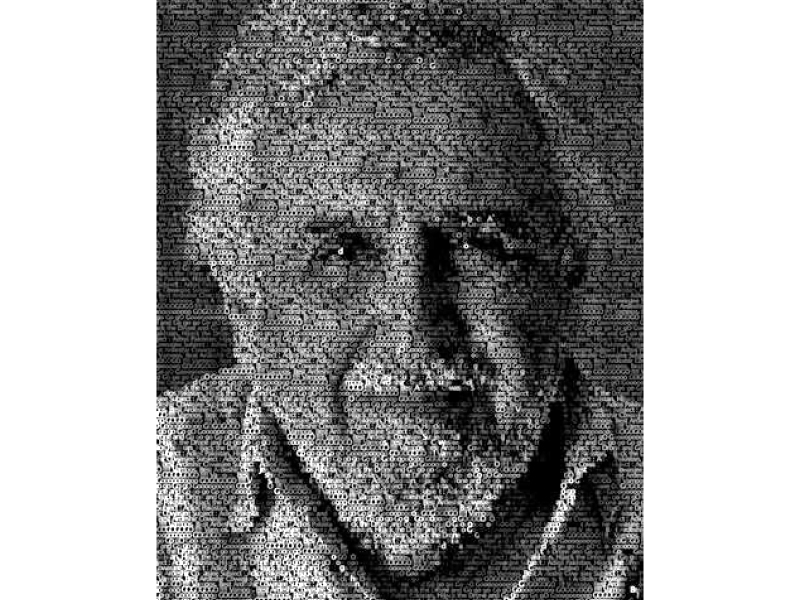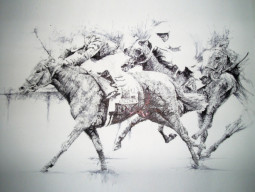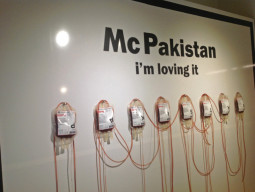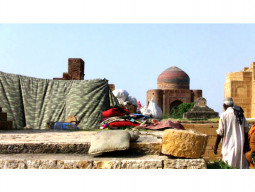
Pakistan has been drawn into the world of drone attacks since 2004. In their endeavour to show the impact of drones on the socio-political sphere, two Karachi-based visual artists, Aamir Habib and Taqi Shaheen, have created visually appealing artwork against the backdrop of drones.
A graduate of National College of Arts, Lahore, Shaheen says that “drawn attacks” is an indirect reference to drone strikes conducted in the Pakistan’s restive tribal northwest. “These drawings are inspired by everyday events happening in Karachi and other parts of the country.”
In ‘Some days are better than others’, political overtones are loud as the artist shows the violence people are exposed to every day. “The people in the visuals are surrounded by armoured vehicles due to escalating violence in the wake of drone strikes.”
In ‘Tomorrow is just another yesterday’, the beard of a Mughal emperor is being held by a British officer. “Historically, we saw this in a different light, but today we might be exposed to the same dynamics.”

One of the artwork pays tribute to the renowned columnist, Ardeshir Cowasjee. In the piece, the artist tries to construct Cowasjee’s “humourous” imagery by using his text on drones. Shaheen explains that after the demise of Cowasjee, he came across an obituary piece written by one of the columnist’s friend. In the piece, the friend wrote that once he sought advice from Cowasjee about returning to Pakistan. Cowasjee told him, “Adios Pakistan. Hijack the drone and go, go, go. Vamoos. Best Ardeshir Cowasjee.” Shaheen quoted the columnist’s friend.
Shaheen feels Cowasjee has contributed to Karachi greatly. “One of his achievements was preventing commercial enterprises from hijacking the area around the mausoleum of Quaid-e-Azam. The area has beautiful gardens now.”

In ‘Skydivers’ and ‘What’s your lucky star’, the black images are what drones actually look like, Shaheen points out. “It depicts the lucky star [drones] Pakistan has been exposed to and, at the same time, questions others about their star.”
Shaheen tries to portray the dilemma the people of Pakistan feel about whether or not drone attacks are meant for their good in the visual, ‘She loves me, she loves me not’. “The image looks like the petals of a flower but it is actually an aerial shot of the top of the drone plane,” he says.
Indus Valley School of Arts and Architecture graduate Aamir Habib uses his art form to depict the primary problems plaguing the lives of people. In ‘Where do we go from here?’ he has constructed a maze to depict the “impossible situation the people find themselves in the wake of rampant killings, drone attacks and rising violence.” According to him, “We can’t live here. We can’t leave either. It is a difficult predicament.”
In ‘Highway to heaven’, he tries to portray the mindset of suicide bombers who want a shortcut to heaven but where is this heaven, Habib questions.
In one of the images, he also expresses dismay over the death of tourists in the recent Nanga Parbat attack. Through ‘Playing on thin ice’, he visually captures the incident, while enquiring about the reason behind their unnatural deaths.
Explaining the use of words ‘la la la’ in ‘Dollhouse’, Habib admits they are just a rhythm for him. He wants the people to comprehend it in whatever way they like.
“We are not starting a new talk through these visuals. Everyone is aware of the talk. It is just my perspective on our basic problems.”
The show, ‘Drawn attack’, will go on till August 24 at the Canvas Gallery.
Published in The Express Tribune, August 22nd, 2013.












































COMMENTS
Comments are moderated and generally will be posted if they are on-topic and not abusive.
For more information, please see our Comments FAQ